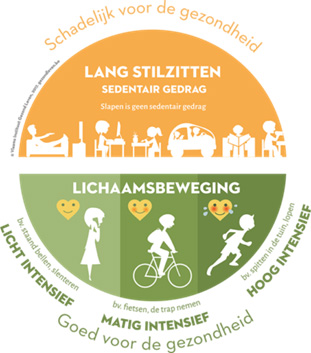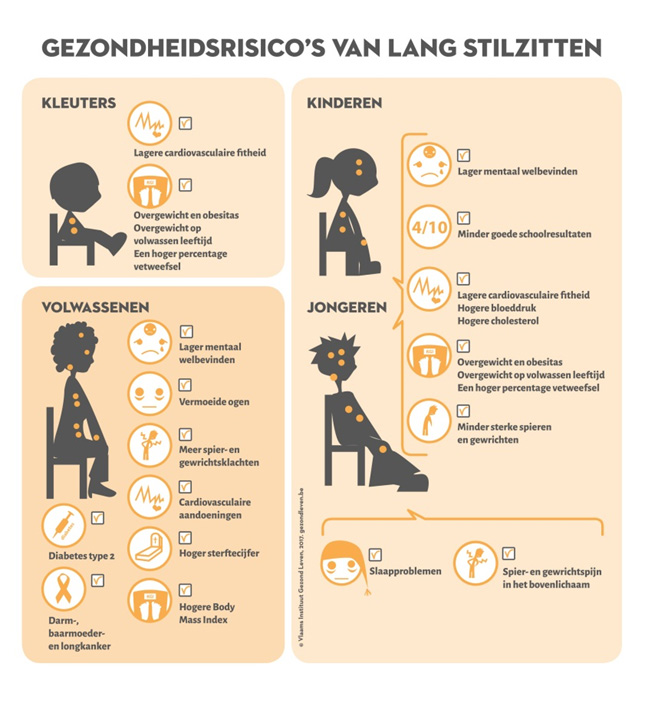Sit less
Sitting or lying still for a long time and using so little energy is also called sedentary behavior.

On average, an adult spends more than eight hours a day sitting: in the car or train, at school or at work, on the couch to watch TV or read a book, at the computer or at the table. Sleeping is not part of this.
Sitting still for long periods of time can lead to health risks. You cannot compensate or eliminate these risks by half an hour of moderately intensive exercise during the day, unless you exercise at least one hour every day at moderate intensity.
A healthy day consists of a mix of:
- sitting;
- movement with light intensity (e.g. standing on the phone, doing the dishes or cooking, walking slowly);
- moderate-intensity exercise (e.g. cycling to work, washing the windows, taking the stairs);
- high-intensity exercise (e.g. brisk cycling, jogging, digging).
Preferably, you break sitting every twenty minutes to half an hour. And that is easy.
Health risks
Your muscles work much less when you sit. Your heart also beats slower. As a result, your metabolism does not run as it should and your fat breakdown is inhibited.
Sitting still for a long time can lead to a lot of physical and mental risks.
If you stand up every half hour and move for a while, you put your muscles in motion again. Your blood circulation improves and your concentration increases.
How to sit less and move more?
You don't have to be an athlete or exercise intensively to get enough exercise.
Change little by little: stand up from your desk or chair every now and then and walk around. Every progress counts!
- Create a healthy mix
Stand, sit and move in your daily life. Alternate between light, moderate, or high-intensity activities (see exercise triangle ).
- Change unhealthy habits gradually
Stand up more often at work, for example to fetch water. Park your car a little further and then go on foot. Do stretching exercises during the commercial breaks on TV. Take a standing coffee break.
- Let yourself be tempted to undertake an intensive activity every week
- Keep yourself motivated
For example, give yourself a healthy reward such as your favorite drink or a terrace with friends. Remind yourself of your reward with a post-it in your calendar.
- Move with pleasure
Choose activities that you enjoy. If you don't like to walk alone, find a group to walk together.
- Adjust your environment to make it easier for you to stand up
Place a standing table near your desk so that you can alternate between standing and sitting to work. Or put the TV remote a little further away so you have to stand up to get it.
- Make your plans as specific as possible
What are you going to do? Where, when and with whom? Eg. on Saturday and Sunday evenings I watch TV with my love for 10 minutes less and instead we go to the park around the corner.
- Do not exercise exclusively in your free time
View the tips below to exercise more at work, at home, on the road, on vacation or in your free time.
- Go for groceries on foot or by bike.
- Regularly work in the garden.
- Do household chores. Cleaning, vacuuming, cleaning windows, washing dishes are ideal moments of exercise. Washing the car and mowing the lawn is also exercise time.
- Stand up when you do something on your smartphone or tablet.
- Get a glass of fresh water regularly.
- Use the commercial breaks during TV shows to stretch your legs.
- Store games, tablets and laptops after use. Make appointments for less screen time.
- Leave the car a little longer . Take the bike, walk or take public transport. Did you know that public transport users take an average of 1,500 more steps per day than car users? An additional advantage: you can also stretch your legs on the tram or train. An electric bicycle can also be a good solution for longer distances.
- Stop regularly if you are in a car for a long time. This is also beneficial for your concentration.
- Go to the station on foot or by bike. A folding bicycle is useful for covering longer distances to and from a station.
- Park your car at the back of the parking lot, so you have to walk a bit.
- Get off the bus or tram one stop earlier than you normally would.
- Do exercises while waiting for a bus or train.
- Do not sit still at your desk for more than twenty to thirty minutes . Stretch every now and then.
- Alternate sitting and standing if there are opportunities to work standing up.
- Use the stairs instead of the elevator whenever possible.
- Take a short walk during lunch break. Or lunch standing or walking.
- Don't place a printer right next to your desk. Place him at a distance so that you have to take a few steps. Do the same with your paper basket.
- Phone standing up. There is a chance that your colleagues will be surprised, but persevere. Before you know it, you will be looked at strangely if you make a phone call while sitting.
- Hold a conversation standing or walking when a colleague comes to your desk for a short consultation.
- See if it is possible to organize a longer standing meeting .
- Go to a colleague instead of emailing. This means you don't just stretch your legs, because sometimes a short conversation is more efficient than sending an email.
- Get a glass of water regularly. This also ensures that you drink enough water.
- Use a toilet located on another floor.
- Make sure you have a good sitting posture.
- Plan sufficient (short) breaks during meetings.
Are you afraid of the reaction of colleagues? Talk about it. There will probably be colleagues who follow your example, making it easier to apply the tips.
- Do not sit at your desk for more than twenty to thirty minutes . Stretch every now and then.
- Alternate sitting and standing.
- Do an exercise activity during lunch break (e.g. walking, dancing, gardening, virtual workout, walking the dog).
- Phone standing up.
- Get a glass of water regularly. This also ensures that you drink enough water.
- Make sure you have a good sitting posture.
- Start it while you are still on your way to your holiday destination. You can do exercises while sitting in the car, plane, train or bus. Sports are not possible, but you can tighten your muscle groups, buttocks, abdomen or back muscles.
- Are you traveling by car? Then stop regularly to stand up. Stretch your muscles. This way you increase your concentration and ensure safe driving.
- In the plane, especially on longer flights, you can occasionally stretch your legs.
- When you arrive at your destination you can start dragging your luggage. Take advantage of this free and useful workout. Make an extra effort and also carry your party's luggage. Just make sure you lift with a straight back to avoid accidents.
- With a beach holiday, both the sea and the beach offer many possibilities. Get out of your lounger and go snorkeling, swimming, surfing, frisbee, petanque or kite flying. Play beach tennis or build sandcastles with the kids. Plan an active day trip.
- Have you opted for a city trip? Get a city map from the tourist office, ask for the nice spots and discover the city on foot. It's much easier to get in touch with local people on foot and soak up the atmosphere. In large cities you can also often rent a bicycle.
- Will you end up in 'the middle of nowhere '? Enjoy the peace and the beautiful surroundings. Walking through the nature reserve is a fantastic way to relax and still exercise. Inquire about local activities. Maybe you can go on a horseback ride, there are marked walks or you can go on a hut trip.
- Are you more of a party animal? Explore the local nightlife and let your legs go on the dance floor. During half an hour of dancing you burn between 150 and 300 kcal.
- Are you staying at home? Get your bike out of the dust and go for a bike ride. Organize a petanque or bowling tournament with friends. Take a day trip to the sea, the Ardennes, Brussels or other beautiful places. You don't always have to go far to still have that holiday feeling.
- For short distances, leave the car in the garage .
- Keep fixed times in your agenda free to do an exercise activity.
- Find a family member, friend or neighbor to exercise together.
- Make time to play or go for a walk with the (grand)children .
- Move a little while you have to wait to pick up the kids from the sports club.
- Join an association that organizes exercise activities.
- Put your remote control a little further and stand up to zap.
- Use the commercial breaks to stretch your legs.
- Combine watching TV with standing household chores such as ironing or cooking.
- Work in the garden. After all, gardening gives you a lot of exercise options.
- Get out into nature . Exercising in nature offers many advantages .


